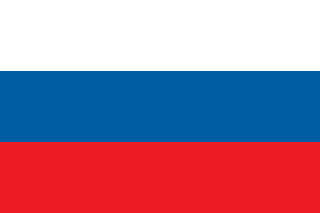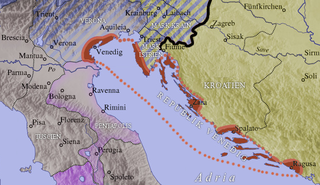
Carniola is a historical region that comprised parts of present-day Slovenia. Although as a whole it does not exist anymore, Slovenes living within the former borders of the region still tend to identify with its traditional parts Upper Carniola, Lower Carniola, and to a lesser degree with Inner Carniola. In 1991, 47% of the population of Slovenia lived within the borders of the former Duchy of Carniola.

The Duchy of Carinthia was a duchy located in southern Austria and parts of northern Slovenia. It was separated from the Duchy of Bavaria in 976, and was the first newly created Imperial State after the original German stem duchies.

Carantania, also known as Carentania, was a Slavic principality that emerged in the second half of the 7th century, in the territory of present-day southern Austria and north-eastern Slovenia. It was the predecessor of the March of Carinthia, created within the Carolingian Empire in 889.

The Counts of Celje or the Counts of Cilli were the most influential late medieval noble dynasty on the territory of present-day Slovenia. Risen as vassals of the Habsburg dukes of Styria in the early 14th century, they ruled the County of Cilli as immediate counts (Reichsgrafen) from 1341 and rose to Princes of the Holy Roman Empire in 1436.

Inner Austria was a term used from the late 14th to the early 17th century for the Habsburg hereditary lands south of the Semmering Pass, referring to the Imperial duchies of Styria, Carinthia and Carniola and the lands of the Austrian Littoral. The residence of the Inner Austrian archdukes and stadtholders was at the Burg castle complex in Graz.

White Carniola is a traditional region in southeastern Slovenia on the border with Croatia. Due to its smallness, it is often considered a subunit of the broader Lower Carniola region, although with distinctive cultural, linguistic, and historical features.

The Duchy of Carniola was an imperial estate of the Holy Roman Empire, established under Habsburg rule on the territory of the former East Frankish March of Carniola in 1364. A hereditary land of the Habsburg monarchy, it became a constituent land of the Austrian Empire in 1804 and part of the Kingdom of Illyria until 1849. A separate crown land from 1849, it was incorporated into the Cisleithanian territories of Austria-Hungary from 1867 until the state's dissolution in 1918. Its capital was Ljubljana.
The House of Auersperg is an Austrian princely family, which held estates in Austria and Tengen. The princely family of Auersperg was a junior branch of the house of Counts of Auersperg from Carniola, one of the hereditary Habsburg duchies in what is now Slovenia. It rose to princely status in 1653 and after acquiring Tengen, they became immediate Princes of the Holy Roman Empire. The princes of Auersperg also held at various times the duchies of Münsterberg and Gottschee. Their territories were mediatised by Austria and Baden in 1806. The family is counted as high nobility.

The Counts of Gorizia, also known as the Meinhardiner, were a comital, princely and ducal dynasty in the Holy Roman Empire. Named after Gorizia Castle in Gorizia, they were originally "advocates" (Vogts) in the Patriarchate of Aquileia who ruled the County of Gorizia (Görz) from the early 12th century until the year 1500. Staunch supporters of the Emperors against the papacy, they reached the height of their power in the aftermath of the battle of Marchfeld between the 1280s and 1310s, when they controlled most of contemporary Slovenia, western and south-western Austria and north-eastern Italy mostly as (princely) Counts of Gorizia and Tyrol, Landgraves of Savinja and Dukes of Carinthia and Carniola. After 1335, they began a steady decline until their territories shrunk back to the original County of Gorizia by the mid 1370s. Their remaining lands were inherited by the Habsburg ruler Maximilian I.

The Marchof Carniola was a southeastern state of the Holy Roman Empire in the High Middle Ages, the predecessor of the Duchy of Carniola. It corresponded roughly to the central Carniolan region of present-day Slovenia. At the time of its creation, the march served as a frontier defense against the Kingdoms of Hungary and Croatia.

Ulrich II, or Ulrich of Celje, was the last Princely Count of Celje. At the time of his death, he was captain general and de facto regent of Hungary, ban (governor) of Slavonia, Croatia and Dalmatia and feudal lord of vast areas in present-day Slovenia, Croatia, Bosnia, Austria, and Slovakia. He was also a claimant to the Bosnian throne. He was killed by agents of the Hunyadi clan under unknown circumstances, which plunged Hungary into civil unrest that was resolved a year later by the sudden death of king Ladislas the Posthumous and the election of Matthias Corvinus, the son of John Hunyadi and Ulrich's son-in-law, as king. Ulrich's possessions in the Holy Roman Empire were inherited by the Habsburg Emperor Frederick III, while his possessions in Hungary were reverted to the crown.

Otto I, a member of the House of Andechs, was Duke of Merania from 1204 until his death. He was also Count of Burgundy from 1208 to 1231, by his marriage to Countess Beatrice II, and Margrave of Istria and Carniola from 1228 until his death.

The March of Istria was originally a Carolingian frontier march covering the Istrian peninsula and surrounding territory conquered by Charlemagne's son Pepin of Italy in 789. After 1364, it was the name of the Istrian province of the Habsburg monarchy, the Austrian Empire and Austria-Hungary.
Jožko Šavli was a Slovene author, self-declared historian and high school teacher in economic sciences from Italy.

Agnes of Merania was a member of the House of Andechs and an Austrian royal consort. By her two marriages, she was Duchess of Austria from 1230 until 1243 and Duchess of Carinthia from 1256 until her death.

Henry II, Margrave of Istria, born c.1175 and died 18 July 1228 in Slovenj Gradec (Windischgraz), was a noble from the House of Andechs who ruled the March of Istria and Carniola from 1204 to 1228. He inherited the County of Stein, and expanded his domains to the Windic March through marriage. He died childless, and his vast possessions were eventually inherited by his niece Agnes of Merania.

The Mark an der Sann was a border march of the Holy Roman Empire, in the territory of present-day Slovenia. It was established in the second half of the 10th century to protect the Empire against its enemies to the east, especially from Hungarian raids.

The Duchy of Merania was a fiefdom of the Holy Roman Empire from 1152 until 1248. The dukes of Merania were recognised as princes of the Empire enjoying imperial immediacy at a time when these concepts were just coming into use to distinguish the highest ranks of imperial nobility.

Frederick I of Celje also Frederick I of Cilli, was a Styrian free noble who became the first Count of Celje, founding a noble house that would dominate Slovenian and Croatian history in the first half of the 15th century.

Ulrich of Sanneck, Lord of Žovnek, was a free noble in the March of Savinja in what was then the Holy Roman Empire and is now in Slovenia. During the struggle between Henry, Duke of Carinthia and the Habsburg rulers of Austria and Styria, he sided with the latter. By accepting the Habsburgs as his liege lords, he was instrumental in transferring the lordship over the Savinja region from the Meinhardiner-dominated Carniola to Habsburg Styria. His second marriage with the noblewoman Catherine of Heunburg would enable their son to claim the Heunburg inheritance in Carinthia and in the Savinja Valley, including the strategically important Celje Castle. This union of the Sanneck (Žovnek) and Heunburg (Vovbre) noble houses would give birth to the House of Celje.




















